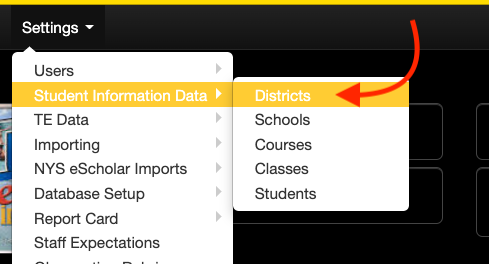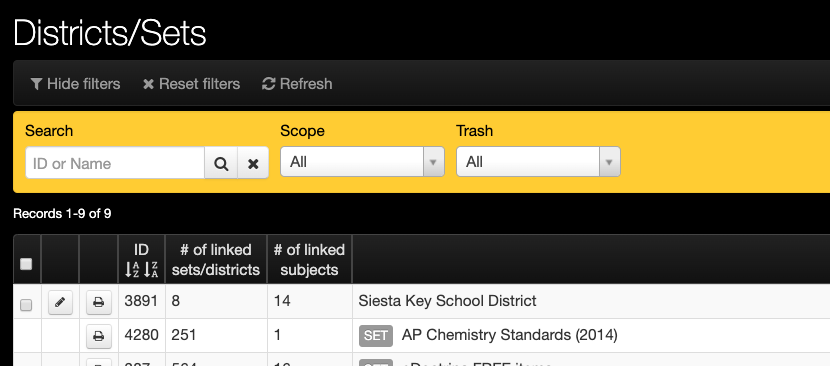District Settings for Observations
Although much of the behavior of the observation rubric or form is determined through the unique configuration of the included elements, there does exist some configuration options that are applied at the district level. These settings will be applicable to all observation rubrics or forms if they are used. Only district admin user types will be able to access these settings and as they should usually be set at the beginning of each year so any behavior in eDoctrina is as expected.
To find the district settings for observation, navigation to the District option located in the Student Information Data sub-menu within the Settings menu on the top navigation bar.

This will navigate to the District/Sets page where all available districts and standard sets will be listed. It is normal to only see one  button as access to edit is restricted for all other districts and sets besides the one that the logged in user is linked to.
button as access to edit is restricted for all other districts and sets besides the one that the logged in user is linked to.

Click the  to enter the district editor where the district settings for observations is located.
to enter the district editor where the district settings for observations is located.

OBSeRVE Settings
All general district observation settings for the OBSeRVE Dashboard, Observation forms, Final Rating selection, and Report options can be found here. Please note that there exists many configuration options within a specific observation rubric. These settings are district-wide options, which means these are the rules that all user in the district will follow in regards to their use of OBSeRVE.
- OBSeRVE Report: within group summary type: This selection only is considered with the none existence of a calculation method within the rubric assignment. Most of the time, this setting does not apply because it is overridden in the observation rubric setup.
- OBSeRVE Report: across group summary type: to be defined in other help guide regarding observation rubric configuration. Most of the time, this setting does not apply because it is overridden in the observation rubric setup.
- Observation report calculation type: to be defined in other help guide regarding observation rubric configuration. Most of the time, this setting does not apply because it is overridden in the observation rubric setup.
- Observation UI: the Observation UI determines which view staff members will be led when accessing the screen where an individual staff members will all be listed. The Scripting user interface option is the most commonly used as it simply lists all available observations, but some districts prefer the Tradtional user interface that aligns all accessible observations in a side-by-side format. This is mostly applicable to how teachers will experience the eDoctrina observations module as most admins have since migrated to use the OBSeRVE Dashboard for managing observations.
- Edit Observe Discussion: If selected, comments made on the main OBSeRVE discussion board can be edited. If unselected, posted comments will be final.
- Observation Comment Draft Option Enabled: If selected, the ability to post a private/draft message will be enabled. A draft comment will only be viewable by the user who made the comment.
- Script Visible by Default: This setting controls the default setting for the Script Visible to Teacher option within every observation form. If this district setting is selected, then all created observations will default to have the scripting area visible. This is only the default setting, so each observation can be updated depending on observer preference.
- Ignore unobserved expectations: Select this checkbox if the default selection for observation rubrics assigned to the district should be to ignore unrated staff expectations. There is also a selection that can be made within the observation rubric assignment and should be verified before finalizing the rubric. Most of the time, this setting does not apply because it is overridden in the observation rubric setup.
- Auto Assign Rubric: If the rubric code has been included on the staff import file, it is possible to auto-assign rubrics if the rubric code has been entered in the observation rubric setup. To make this work, the rubric codes must be entered first, then the staff import file must be run after this feature has been enabled. This will create the rubric assignment on the OBSeRVE Dashboard automatically upon staff import.
- Auto Assign Observer: This feature is also closely linked to the staff import file. With the presence of department codes, this feature will assign observers to teachers if and only if this configuration option is checked. All users who are observers will be assigned as the observer for all users who match their department code. This action will NOT be removed existing observer assignments.
- Allow final rating selection: Selecting this checkbox will allow admins to choose the Final Rating for an observation assignment from a pull-down menu or enter a score on the Final Rating Layout view of the OBSeRVE Dashboard. This can work independently as the option to remove the final rating is an option in the pull-down. Enabling this option will allow admins to create a Final Rating without entering the OBSeRVE Editor.
- Confirm final rating selection: Selecting this checkbox will force the admin to select the "Save Rating" button on the Final Ratings view of the OBSeRVE Dashboard. This button will be modified to a "Remove Final" button as soon as the Final Rating is saved. This option will be completely unavailable if the "Allow final rating selection" is unchecked.
- Include SSIN on Reports: Selecting this checkbox will add the staff members state identification number (if it exists in eDoctrina) to most of the reports that are generated for an individual user through the OBSeRVE Dashboard
- Auto Save Observation: Selecting this checkbox will enable the Auto-save feature which will save all entered information at a 3 second delay. This selection should be confirmed by the district as there are advantages and disadvantages to this feature. Unless admins are thoroughly trained to ensure internet connection and click save frequently, it is highly recommended to use this option.
- Non-Draft by default: Selecting this checkbox will make all conducted observation non-draft (complete) by default. This should be enabled if your district would like to share observations as soon as they have been initiated. This selection should be confirmed by the district as most will want the draft option to be the default.
- Use access rights instead of "Is Observer" for observation rights: The permission "Is Observer" is a simple toggle switch that provides users with access to the OBSeRVE Dashboard to conduct and manage observations. This option does not depend user permissions, which means it is not flexible. Enabling this option will allow a more granular configuration by using Observe access rights defined for specific users or user groups as primary allowing districts to define user access rights in for the OBSeRVE Dashboard. This is usually used in districts that have a large variety of user types or districts that would like to use department codes as the determining factor of which observer sees which staff members on the OBSeRVE Dashboard.
- Electronic Signature by non-logged in user: Selecting this checkbox will allow someone to electronically sign an observation through a different user's account. This will allow an administrator to sign an observation then have the teacher sign it immediately after without having to change who is logged in. The password will determine who is the person providing the signature.
- Show secondary observer combo: Enabling this option will add another field to indicate another observer to have access to an observation. The secondary observer will display on printed observations and will have similar access rights as the observer.
- Observee Signs First: Enabling this configuration setting will change the electronic signature workflow for the entire district to have the observee provide their electronic signature first. The observer will sign the observation after this signature has been provided.
- Show Overall Evaluation Summary in Observe Dashboard: Enabling this feature will place the Teacher Effectiveness or End of Year Summary Report on the assignments layout view of the OBSeRVE dashboard.
- Allow finalize within observation editor: Enabling this feature will allows final rating selection to be made within and observation form. This feature is usually used when there exists a closeout observation or evaluation event at the conclusion of an observation period where the observer can select the final rating and send the value to the TE system in one action.
 Save as PDF
Save as PDF